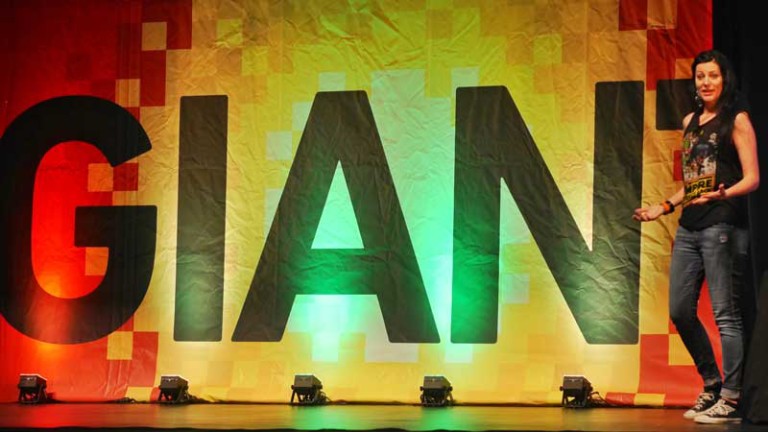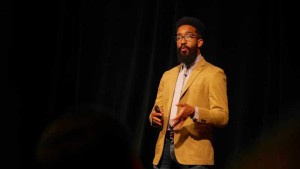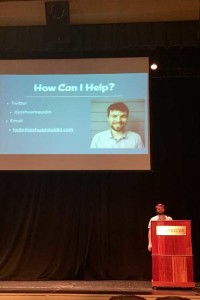I had some good feedback from people about the detail of my notes from day one at Giant Conf 2015. This was really down to how well structured some of the sessions were, especially from Scott Berkun and Kevin Hoffman’s sessions. Some of the other speakers spent a lot of time telling personal stories, which were awesome and inspiring, but I found myself only taking notes of the main point of the story and left out a lot of the detail.
Here are the rest of my notes from day one.
Pulling the breaks: fostering transparency, communication, and collaboration in design teams – Eduardo F. Ortiz
The general gist: Share everything you do. Put everything out in the public domain. The feedback you get will validate your ideas and process.
- Design in the open. – share tools, share artifacts, share documentation
- DOCter template for project documentation: https://github.com/cfpb/DOCter
- Empathy – Show empathy towards the community
- Collaboration – Collaborate with your users. Everyone can provide value.
- Transparency – Be honest with how decisions are made with your team.
- Align your team with a common goal.
Does this paragraph make me look fat? – Joshua Mauldin
The general gist: A beginners overview of the basic concepts in typography. Helvetica is over used.
- A typeface is a collection
- A font is a specific version of a typeface
- General typeface categories:
- Serif
- Sans-Serif
- Slab-Serif
- Decorative
- Script
- Choose typefaces that represents the tone of the brand.
- Check for Multilanguage support, and support for oldstyle figures
- Sans-Serif usually work best for headlines. Serif is better for readability in print.
- Give enough leading/line-height to make it easy to read from line to line. You have to consider the readability on small and large screens.
- When pairing typefaces, try taking them from the same designer or the same historical era.
- http://www.sudtipos.com
- http://www.typography.com
- http://www.marksimonson.com
Through Burnout and Back Again: UX Skills that Saved My Life – Jaimee Newberry
The general gist: Love what you do because life is short. The design toolkit is there to solve problems. They can be used to dig you out of your burnout and help design your life. Don’t give up. Keep going and celebrate small wins.
- “All I want to do, is go the distance” – Rocky Balboa
- Understand the problem. Ask the right questions.
- Try different things to make the puzzle pieces fit together
- Design should be about finding solutions to problems.
- Example: Disney Magic Band – solved the contextual problem of having to carry stuff around the park such as credit cards, room key, ID.
- Book recommendation: The Power of Habit – Charles Duhigg
- Change habits by:
- Trigger – Knowing how to identify the problem e.g. licking your teeth to know if they feel rough/dirty
- Action – what to do about it e.g. brush your teeth
- Reward – the outcome e.g. fresh breath
- Tiny Habits method to change your behavior: http://tinyhabits.com/
- Break down the habits into small tasks and tiny changes.
- “Celebrate the little things” congratulate yourself on what you do get done.
- Iterate
- Watch fail or succeed, learn and then try again
- It’s not about what’s next, it’s about what’s important
- Test, tweak and revise
Infinite Possibilities – Denise Jacobs
The general gist: Creativity is a highly sought after skill for leaders. Everybody has creativity in them, but not everybody exercises it.
- A TIME poll found that 94% of people said that creativity was a skill they sought after.
- IBM study found that creativity is the most important leadership skill
- 80% of 6 yr old kids say they’re creative. By 16 only 10% of kids say they are creative.
- Amp up your creativity frequency with practice.
- Come up with 10 ideas a day. They don’t have to be good ideas.
- Train your brain to come up with ideas.
- How often do you actually listen to your own ideas?
- How often do you give them time and attention and actually doing something with them?
- You can choose to be creative. It’s not a guarantee that it will come, but you have a better chance than if you choose not to be creative.
- Fixed Mindset vs Growth Mindset
- Fixed Mindset
- Believes in talent
- Fears failure
- Strives for perfection
- Compares to others
- Growth Mindset
- Believes in learning
- Feeds curiosity
- Self referential
- Not afraid of failure
- Change from a Fixed to Growth mindset:
- Listen out for your fixed mindset voice e.g. “I can’t do this, I’m not smart enough”
- Realize you have a choice. If you don’t try, you fail.
- Adopt a beginners mind and always be learning.
- Release the tyranny of the expert. Don’t expect or try to know everything.
- Relearn from friends, rediscover the familiar.
- Experience flow: when you’re in a timeless, transcendent state with extreme focus.


